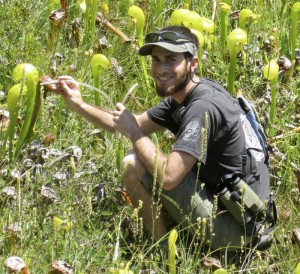 I was born and raised in the San Francisco Bay Area’s coast range where I spent my earliest years on hand and knee amongst oak woodlands, peering under stones and logs for creatures more fantastical than any children’s book could illustrate. When it came time to choose a project for my high school thesis, I argued that the many hallmarks of human civilization – notably the domestication of crops and animals, division of labor, slavery, warfare and altruism – were achieved by ant civilization while our own ancestors were eking out an obscure existence in the African treetops.
I was born and raised in the San Francisco Bay Area’s coast range where I spent my earliest years on hand and knee amongst oak woodlands, peering under stones and logs for creatures more fantastical than any children’s book could illustrate. When it came time to choose a project for my high school thesis, I argued that the many hallmarks of human civilization – notably the domestication of crops and animals, division of labor, slavery, warfare and altruism – were achieved by ant civilization while our own ancestors were eking out an obscure existence in the African treetops.
This fascination with ants, which remains the focus of current research, was fostered by a predisposition for staring at the ground, a family vacation to the jungles of Central America, and an early reading of E.O. Wilson and Bert Hölldobler’s “The Ants” and “Journey to the Ants.” My interest in these small creatures led to a job at the Essig Museum of Entomology as an undergraduate at University of California Berkeley, and to an impressionable semester abroad in Costa Rica with the Organization for Tropical Studies. After a year working on an organic farm in Mendocino, and a summer stint in the Smithsonian’s insect collection, I joined Phil Ward’s ant systematics lab to pursue a doctoral degree in entomology from UC Davis.
Although my dissertation research would eventually settle on the systematics, biogeography, and conservation of the Fijian ant fauna, my initial plan was to use phylogenetic comparative methods to determine what life-history traits allow an inordinate number of Tetramorium ants to break free of their native ranges and spread across the globe as successful tramp species. My first pursuit of these globe-trotting invasives and their endemic sister-species took me to the Pacific islands of New Caledonia, Fiji, and New Guinea. The challenges of conducting research in New Guinea colluded with the persuasive arguments of Dr. David Olson – a fellow ant enthusiast who was directing a conservation organization in Fiji, to pivot my thesis work towards the more achievable goal of revising the ant fauna of the Fijian archipelago – a feat last attempted nearly a century ago.
Invasive ants found a way back into my research program when, during my fieldwork in Fiji, I became involved with an international coalition seeking to protect Pacific Island nations against the environmental, agricultural, and human health impacts being wrought by invasive ant incursions. In this capacity, and with funding assistance from the USDA and Biosecurity New Zealand, I developed the web-based resource PIAkey: an identification guide to invasive ants of the Pacific Islands. The PIAkey project was expanded as a postdoc with Dr. Andrew Suarez (University of Illinois at Urbana-Champaign) and as a Encyclopedia of Life Rubenstein Fellow. The resulting project, Antkey.org, uses the Scratchpads.eu platform. It expands the geographic and taxonomic scope to a global level and includes many new features. Work on the site is continuing.
I am currently living on an off-the-grid homestead in California’s Klamath National Forest at the base of the Marble Mountain Wilderness with my wife, Julia Schreiber. My research work continues as manager of Antwork Consulting. Current projects include close collaboration with Evan Economo’s lab in Okinawa, additional development of Antkey.org in collaboration with Kandoorie Farm and Botanical Garden, and providing ant identification services.
